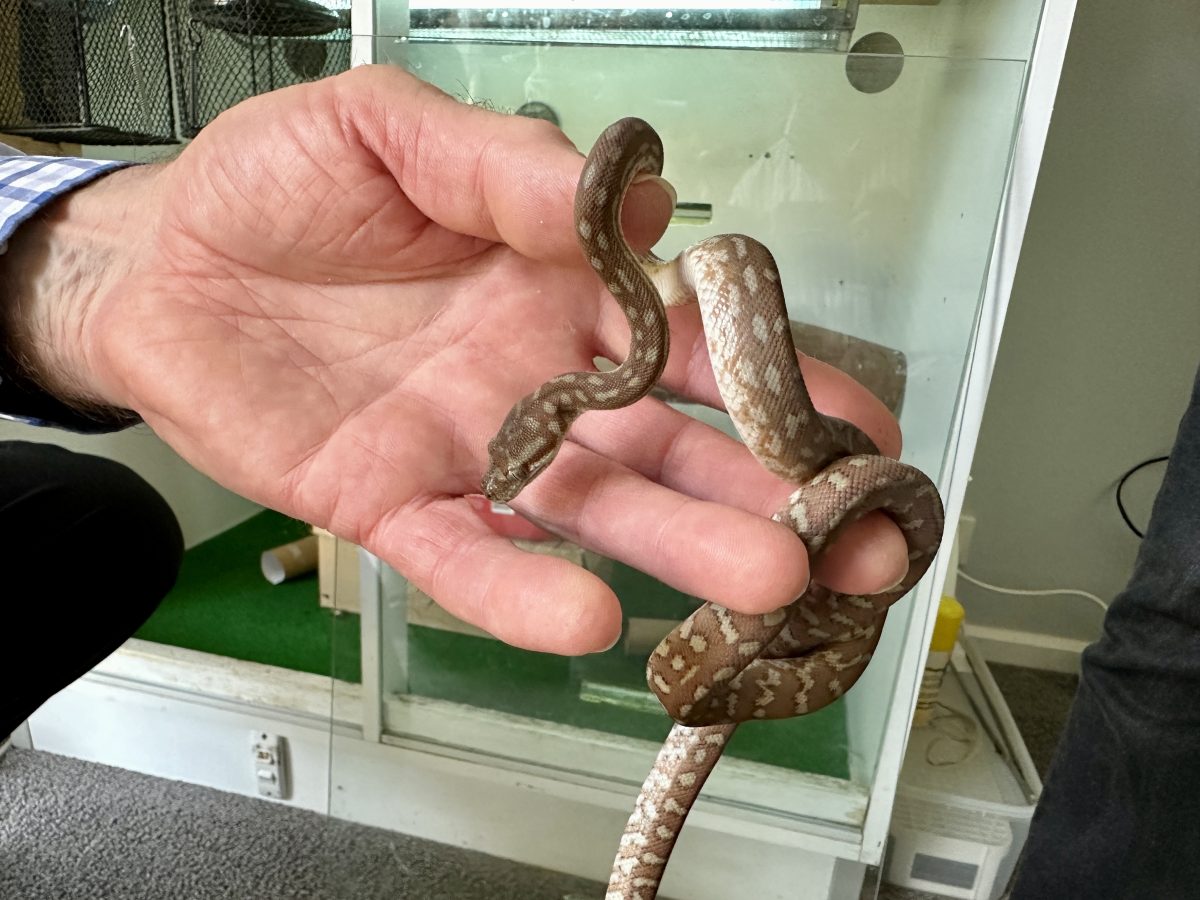
Dennis Dyer and his 10-year-old Bredl python, ‘Ben’. Photo: James Coleman.
When Margaret Ning and her husband bought a property in Nimmitabel in country NSW in the mid-1980s, they set out on a mission to identify all the creatures living on it.
She joined the ACT Herpetological Association (ACTHA) to learn more about the snakes and lizards on the site. That’s where she also met people who kept them in their living rooms as pets, including Dennis Dyer.
“You have to move slowly,” Dennis says as he slides open the glass doors to his terrarium and stretches out his hand to a rippling length of striped muscle on the faux-grass base.
Ben is 10-year-old Bredl python, a species most common to Alice Springs in the Northern Territory. He’s harmless, a point which I’m desperately trying to force-feed into my faculties as his triangular head levitates towards my hand, forked tongue flicking the air.
“I had another one, but he got cancer of the liver and died four years later,” Dennis says.
“Two of my children told me I needed another one. And so I said, ‘yeah, I’d like a Bredl python’, so this guy in Sydney was breeding them at the time, and I went up there and bought a male and female.”
They’ve since mated and the offspring are currently coiled up in another glass tank in Dennis’s living room.
Of all the pet types in Canberra, snakes are relatively rare. Well, except for the accounts of drug dealers who “often have pythons that end up with licenced handlers when police go in and confiscate things”.
Above the law, snake owners must secure a permit from the ACT Government. Anything slightly venomous is off the cards except for a handful of professional handlers, so carpet and diamond python varieties are the most common.
It’s been a month since Ben last ate. Feeding live animals to snakes is also illegal, so Dennis fetches a rat he took out of the freezer earlier in the morning and left to thaw in the sun before placing Ben in a clear container and hovering the corpse over his head.

Delicious. Photo: James Coleman.
Within seconds, Ben’s fangs are embedded in the rat’s head and his body is wrapped around its body.
“He’ll open his jaws right up and use his neck muscles to force it down to his stomach soon,” Dennis says.
Canberrans will be able to see all of this gruesome action – and more – from 8 to 14 January at ‘Snakes Alive’.
This is described as the association’s “biggest event of the year”, organised by Margaret Ning and presented during the school holidays in partnership with the Australian National Botanic Gardens (ANBG) for 25 years now.
The Canberra Reptile Zoo in Kambah also enters other reptiles and amphibians in the form of crocodiles and turtles, while Dr Gavin Smith from the Canberra Snake Tracking Project brings along a three-metre-long container of venomous snakes.
All up, 40 species will be spread across two air-conditioned rooms at the gardens – many threatened, endangered or rarely seen. There are feeding sessions, handling sessions, and for the first time in 2024, a sensory session.
“A lot of kids with special needs don’t like crowds, and we can have up to 150 people attend each session, so we’ll lower these numbers and the lighting to help,” Margaret says.

A baby Bredl python. Photo: James Coleman.
Entry prices have had to go up over the years to cover costs, but the association is keen not to “preclude kids from lower-income families”.
“Also, for the first time this year, we’ll be giving The Smith Family about 20 free tickets a day over all seven days.”
The aim of the event is to encourage “healthy respect” for snakes without overconfidence.
“We want kids to leave snakes alone when they come across one in the wild and not try to pick it up,” Margaret says.
“But the event was started in the days of the ‘kill every snake’ rhetoric. And I’ve seen slow changes in my friends on properties who would have previously killed them and now thinking not.”
Buy tickets to Snakes Alive on Eventbrite (adult $9, child $7).












